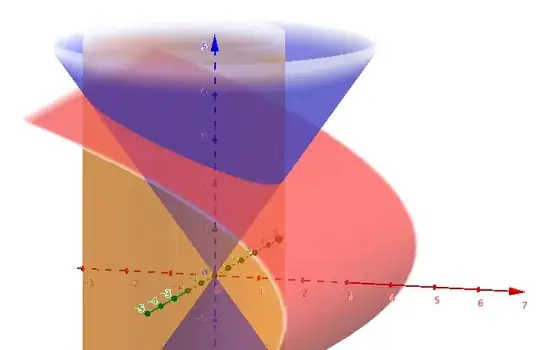In this answer, I derive a formula for the eccentricity of an ellipse in terms of angles made by the surface of the cone, and the cutting plane, with a "horizontal" plane (perpendicular to the axis). Complementing (for the sake of easier description here), we can restate the formula as
$$e = \frac{\cos\theta}{\cos\phi} \tag1$$
where $\phi$ is the angle made by (a generator of) the cone and its axis, and $\theta$ is the (non-obtuse) angle made by the cutting plane (or, more-specifically, the conic's major axis) and the cone axis. It easy to show that, for the case of a cylinder, the corresponding relation matches the result of setting $\phi=0$ (and writing $\theta'$ to distinguish from $\theta$):
$$e = \cos\theta' \tag2$$
So, if a cone and cylinder have a planar (thus, elliptical) intersection, then the ellipse's major axis makes angles $\theta$ and $\theta'$ with their respective axes, such that
$$\cos\theta'=\frac{\cos\theta}{\cos\phi} \tag3$$
Thus, given any plane cutting a cone in an ellipse, we can find an appropriate cylinder that has the ellipse as its intersection. (Technically, the ellipse may only be part of the overall intersection.) Knowing $\phi$ and $\theta$, we use $(3)$ to find $\theta'$. (Note: Given that the plane cuts the cone in an ellipse, we know $1>e=\cos\theta'$ so that $\theta'$ is defined.) This angle determines the cylinder's axis through the ellipse's center; in fact, for $\theta'\neq \pi/2$, we have two possibilities for that axis. The desired cylinder's radius is necessarily the ellipse's minor radius. So, generally, there's are two families of configurations (essentially parameterized by $\theta$ and a scale factor, and the choice of cylinder axis) of cones and cylinders having (partially) planar intersection, with no requirement that the cone and cylinder have parallel axes.
That said, in the particular case where the cone and cylinder do have parallel axes, then $\theta=\theta'$. Assuming $\phi\neq 0$ (the cone is non-degenerate), then the only way to satisfy $(3)$ is with $\cos\theta=\cos\theta'=0=e$: the intersection is a circle. Clearly, the cylinder's axis necessarily coincides with the cone's. An "offset" configuration ($a\neq 0$ in the question) is invalid, re-confirming conclusions made in other answers.
